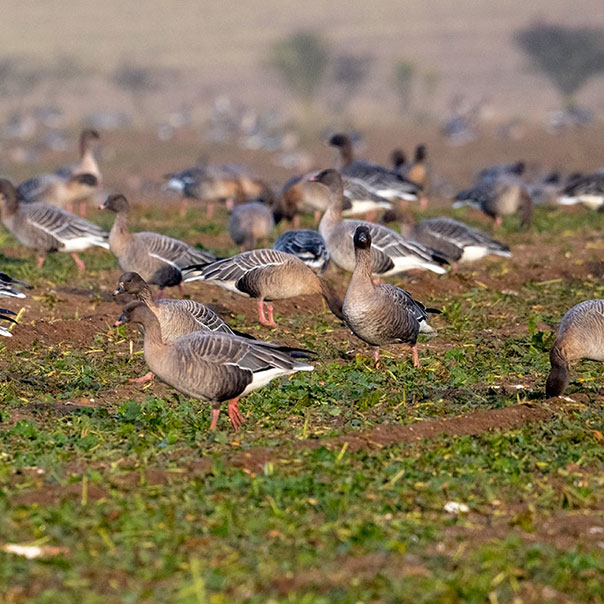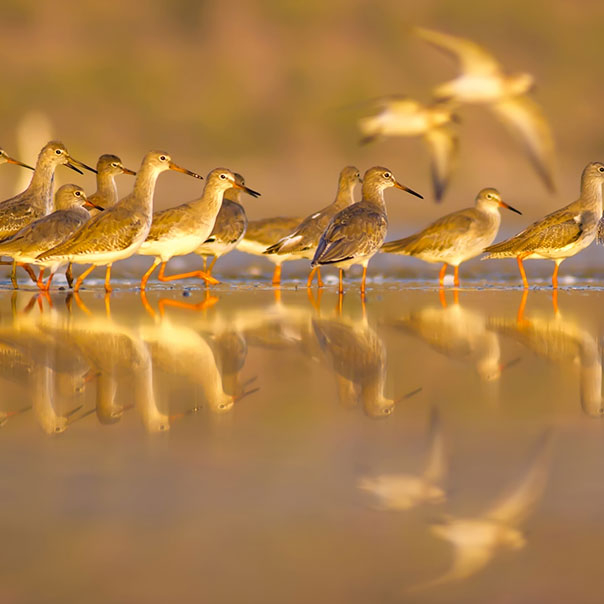Wetland wildlife in September
Autumn is truly upon us; waders are passing through our wetlands on their way south, geese are arriving and there are still plenty of dragons and brightly-coloured flowers to seek out.
It's now September and peak migration season for many species of bird. Leaving their breeding grounds to head south for the winter, most are on passage, looking to stop-off and use our wetlands to rest-up and feed.
Heading south
Since August, we’ve seen waders piling in from the north as they leave their breeding grounds and head south towards wintering grounds. Some will stay with us through the coldest weather but many will be pushing on further south to where they can continue to easily feed, away from frozen ground. They are now coming thick and fast; species such as greenshank (see header image), curlew sandpiper, whimbrel, little stint and dunlin are all using our wetlands to rest and refuel.

Autumn migration arrives at a more leisurely pace than what we experienced in spring; when birds are in their smartest plumages but rarely stick around for long in the rush to get to their breeding grounds. In autumn, the birds can take things slower, meaning you’ll have a better chance of catching up with them. For example, it can be tricky to see birds such as curlew sandpiper and little stint on spring migration, but they are more easily seen in autumn. One factor here will be because they use a different migration route for each season, but additionally there are now many juvenile birds taking on their first migration. They aren’t so sure of their route and are more likely to wander off course and reach wetlands in the UK. The juveniles can be a real treat to view in the fresh new plumages at this time of year, whereas the adults likely won’t look too smart as they move to their winter plumage.
It's also time for birds that have spent the breeding season in UK wetlands to move south. Little ringed plover, garganey, common tern, osprey, yellow wagtail, sand martins, sedge and reed warblers will hopefully have fledged young and are now feeding up before they start their migration.
Before the month is over, most will have headed south. These birds are doing the reverse of their spring migration but may use different stopover sites. The length of time a bird will rest varies from a few hours to a few weeks depending on the species, availability of food, the speed the bird can put on fat and the weather.
A shorter journey
As well as those species that cross continents, you might notice those that move over a shorter distance. Around 2,000 pairs of avocet breed in UK wetlands during the summer months in large colonies, often on freshwater shingle islands, before moving to coastal mudflats and estuaries to winter. There, they’ll be joined by around 7,000 more of their kind, escaping harsher weather in northern and mainland Europe. Many of our oystercatchers make similar movements, but they’re a lot more numerous. Nearly 100,000 pairs breed on UK wetlands over the summer with around three times that number using our warmer coasts as wintering grounds.

Geese inbound
As well as the waders, it’s time for larger waterbirds to make an entrance. Pink-footed geese have spent the summer in Iceland on breeding grounds, but they’re now heading south across the Atlantic. Towards the end of September and into October, large numbers of these birds will be seen at WWT Martin Mere, Caerlaverock and Welney – numbers peak in October but some flocks will move off to winter at other sites.

The ‘pinks’ have come a long way from their breeding grounds in Iceland however there are other species on the way from a lot further afield. From Greenland and the east Canadian high arctic come light-bellied brent geese, which make a huge migration, with much of the population alighting on the shores of Strangford Lough at WWT Castle Espie. They’re here to feed on eel grass; some stay the winter but others will move to other locations, famously to the city parks of Dublin.

Dragons and damsels still on the wing
Many dragonflies are still on the wing in September; migrant hawkers will be the key larger dragonfly but you will still be able to find other species that will soon come to the end of their flight period. This includes southern hawker and emperor dragonfly, four-spotted and broad-bodied chasers and red-eyed damselfly.

Wetland plants
The bright yellow of common fleabane can be spotted flowering in many damp places; look out for its chrysanthemum-like flower and hairy, wrinkled leaves. As its name suggests, in the past it was dried and used in homes to drive away insect pests.
Around stream banks you can also search for devil’s-bit scabious, another late flowerer with rounded, purple flowers resembling a pin-cushion. It’s so named as they have very short roots; legend tells that the Devil bit the roots off in anger at the plant's medicinal properties.

Where to see September wildlife
You’ve a chance of seeing any of the migrating birds mentioned above, at any wetland site. The waders will be especially drawn to shallow water and mud where they can search for their invertebrate food.
Find your nearest WWT wetland site
Migrant hawker, southern hawker, broad-bodied chaser and emperor dragonfly can be seen throughout much of England and Wales but get rarer the further north you go. Four-spotted chaser is common throughout the UK but red-eyed damselfly is common only in south, central and eastern England.
Devil’s-bit scabious is widespread throughout the UK. Fleabane is common in England and Wales but gets scarcer further north.

October
Next time, we’ll be into October and wader passage to the UK continues, but there are plenty of species still incoming to spend the rest of the autumn and winter with us. This includes the majority of duck species, and the start of the swan season.
Wetland wildlife in OctoberSupport from players of People's Postcode Lottery helps us care for our reserves and protect amazing wetland wildlife.



